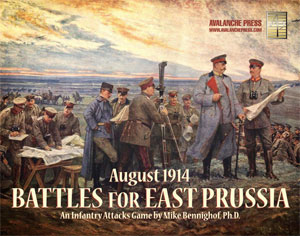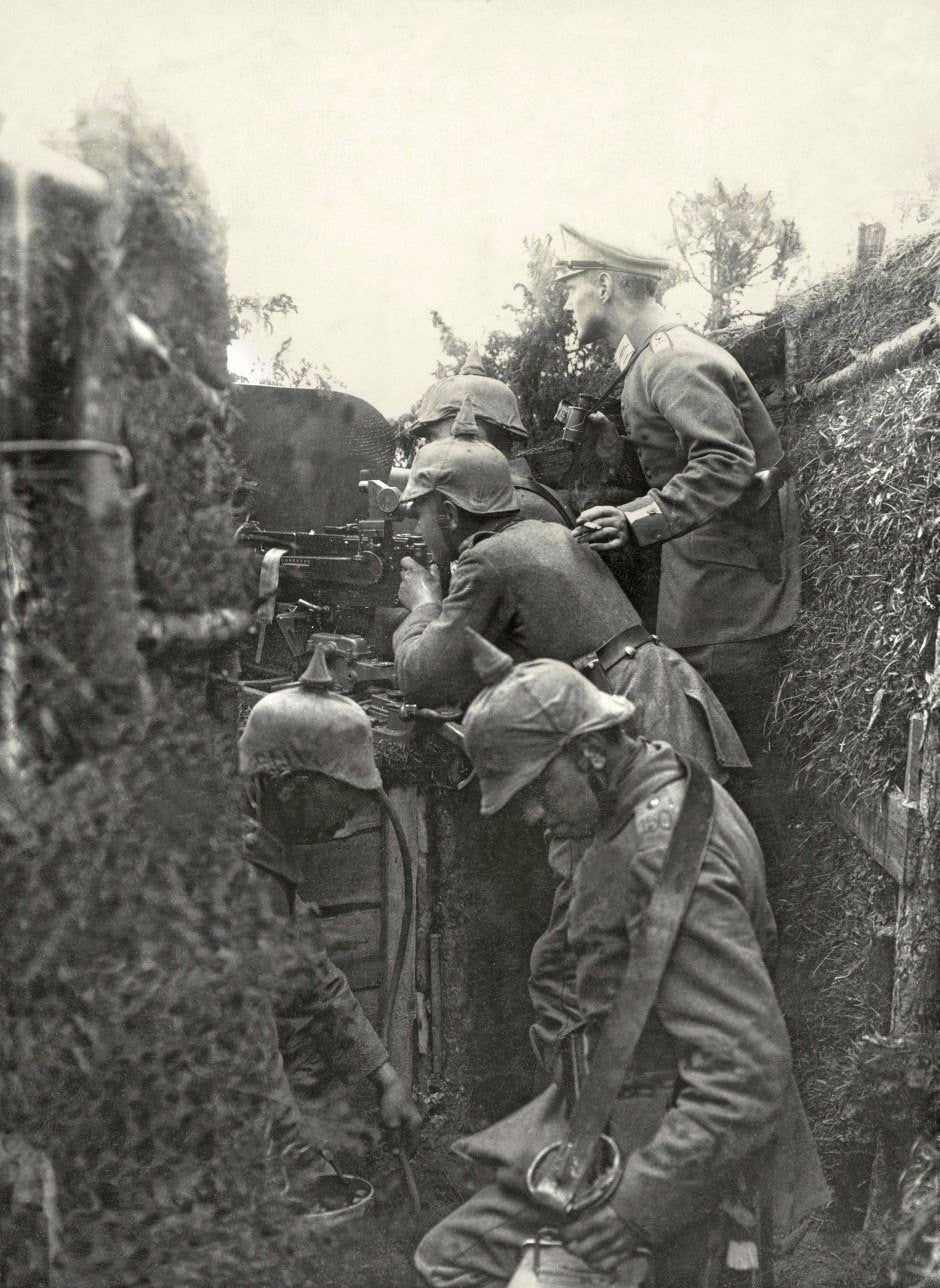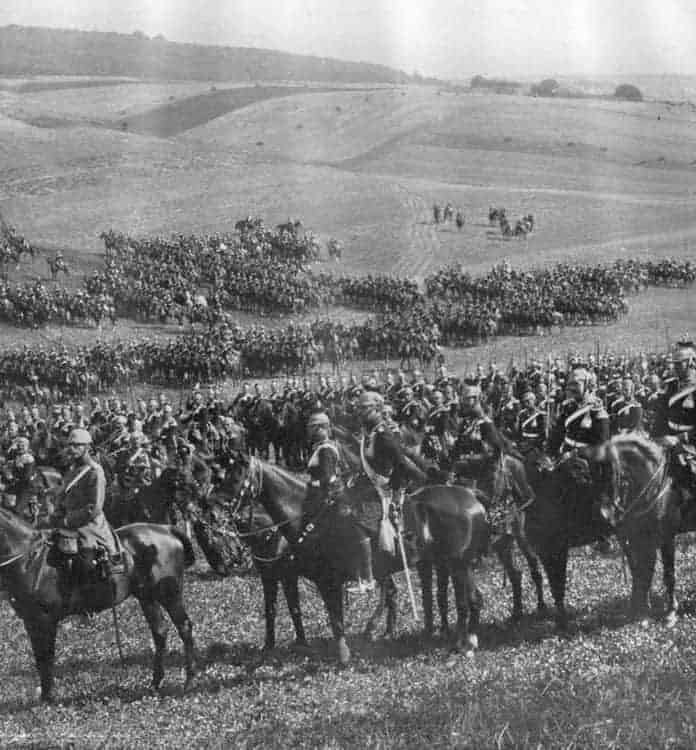| Tannenberg 1914:
Part Three, Day One
By Mike Bennighof, Ph.D.
September 2020
 On Second Army’s front, the VI and XIII Corps spent their first day in German territory, August 21st, marching stolidly to the north-west. They had already spent days slogging along dirt roads and sandy soil just to get to the border, and already their supply columns had begun to lag. As if that were not bad enough, the 21st also saw a solar eclipse, considered a particularly bad omen by many soldiers and officers for the coming days. On Second Army’s front, the VI and XIII Corps spent their first day in German territory, August 21st, marching stolidly to the north-west. They had already spent days slogging along dirt roads and sandy soil just to get to the border, and already their supply columns had begun to lag. As if that were not bad enough, the 21st also saw a solar eclipse, considered a particularly bad omen by many soldiers and officers for the coming days.
Second Army’s corps came from three different military districts, but its staff had been formed from those of Warsaw Military District’s command staff left over after North-West Front had had its pick of the best officers. They openly referred to themselves as “rejects,” and a split between commander Alexander Samsonov and chief of staff Pyotr Postovsky did nothing to help matters. Samsonov was part of the clique centered around War Minister Vladimir Sukhomlinov, while Postovsky joined Grand Duke Nikolai Nikolayevich in heaping scorn on Sukhomlinov’s push for modernization, planning and training. The logistical system had been completely re-organized just before mobilization, which confused quartermasters at every level. The requisitioned civilian transport proved inadequate, and even the heavy army wagons had too few horses to negotiate the sandy unpaved roads of Russian Poland.
On the German side, Moltke briefed Ludendorff on the evening of 22 August. The new Eighth Army chief of staff quickly drafted and telegraphed new orders to all of the German corps headquarters, using the excellent East Prussian railway system to bring I Corps to join XX Corps on the Russian left flank and setting XVII and I Reserve Corps to block the Second Army’s right-flank advances and prevent a junction with First Army. After requesting and receiving a Landwehr division as a reinforcement, he sent it orders to join the forces on the Russian left flank as well, and then received the Pour le Mérite from Kaiser Wilhelm II in recognition of his exploits at Liege. Hindenburg joined him for the train ride to East Prussia, approving the new deployments before settling in for a nap.

Open in a new tab to embiggen the map.
Meanwhile, Rennenkampf at Russian First Army headquarters paused for a day and a half to re-organize his forces before beginning a slow advance to the west. Neither air nor cavalry patrols detected the German re-deployment, and the Russians moved cautiously out of concern for a German counter-attack. First Army had advanced up the main rail line leading from East Prussia into Russia, but as Russian rolling stock could not operate on German rails horse-drawn supply wagons had to bring up rations and ammunition.
Second Army’s columns finally collided with the German XX Corps screening the border on 23 August, just as the new command team arrived in East Prussia. Friedrich Scholtz’s regulars had the task of slowing the Russian advance, but instead heedlessly and needlessly launched bloody frontal assaults in an effort to drive the Russians off German soil.
The fury of the German attacks unintentionally helped mask Ludendorff’s planned counter-offensive, which opened on 26 August. The German I Corps commander, Hermann von François, refused to attack without his full allotment of artillery. But Hindenburg was no Prittwitz, and after a brief conference François understood that I Corps would attack whether he remained in command or not.

A German machine-gun crew poses near Tannenberg.
The Russian I Corps held Samsonov’s left flank, and reconnaissance detected the arrival of the German I Corps and its preparations to attack. Samsonov ordered the elite 3rd Guards Division and 1st Rifle Brigade to support it along with two cavalry divisions. But none of those formations could arrive before the Germans struck.
When the attack came, François sent his troops forward hours late and at partial strength. Not all of his corps had arrived, and he sent Eighth Army headquarters a stream of false reports pretending that they had and had made good progress. I Corps halted the attack in mid-afternoon, with none of its objectives having been taken. Overlooking the lies, Ludendorff later admitted that François had been right to seek delay, that a defeat would have unraveled the encirclement plan and Second Army would have, at best, been driven out of East Prussia rather than destroyed. For his part, François told a critic years later that things looked quite different on a battlefield than they did from a library.
While I Corps stalled, to its left XX Corps with 3rd Reserve Division fought off attacks by the Russian XXIII and XV Corps, which still attempted to advance to the north-west. The Russian Second Army had little idea where its own corps stood, and ordered its I Corps to hold off the German I Corps on the left while the remaining corps pressed forward on the 27th. On the Russian right, VI Corps was to leave a small force behind and join the advance of XIII Corps on the key rail junction of Allenstein.
But VI Corps had problems of its own. A full cavalry division had been attached, but it remained concentrated and did not form a screen, while the small divisional Cossack detachments failed to detect any Germans to the corps’ front. Russian airmen did spot advancing columns of troops, but identified these columns as elements of Rennenkampf’s First Army. They were not.

The German 1st Cavalry Division assembles.
On the German left, Hindenburg and Ludendorff had formed the Ostgruppe of August von Mackensen’s XVIII Corps and placed I Reserve Corps under his command as well. Mackensen redeemed his poor performance at Gumbinnen, bringing his troops into position in time for the scheduled 4 a.m. attack, and after an artillery bombardment they went forward. The Russians fought hard, but the reservists turned their left flank and by nightfall a disorganized retreat had become a rout. VI Corps pulled back 30 kilometers without any German pursuit and the Russian XIII Corps to their left now had their own flank exposed. Corps commander Alexander Blagoveshchensky waited until 2 a.m. to admit the disaster to Second Army headquarters.
If the Germans ended the day with only one jaw of their pincer closing in, things had gone well all the same. I Corps was now in position to carry out its attacks at full strength and XX Corps had held its ground and kept the Russians in check. Mackensen prepared to push both of his corps forward relentlessly, falsely believing that Rennenkampf’s First Army, which had beaten him so badly less than a week before, was advancing behind him and he could either advance himself or be crushed between the two Russian armies.
You can order August 1914 right here.
Please allow an extra three weeks for delivery.
Sign up for our newsletter right here. Your info will never be sold or transferred; we'll just use it to update you on new games and new offers.
Mike Bennighof is president of Avalanche Press and holds a doctorate in history from Emory University. A Fulbright Scholar and NASA Journalist in Space finalist, he has published untold numbers of books, games and articles on historical subjects.
He lives in Birmingham, Alabama with his wife, three children and his dog, Leopold.
Want to keep Daily Content free of third-party ads? You can send us some love (and cash) through this link right here. You don’t have to, but Leopold would like it if you did.
|
